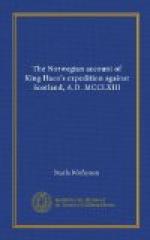It would be improper for the editor to draw any comparison between the Scottish and Norwegian narratives; he, therefore, leaves it to the discernment of the reader to fix what medium he thinks reasonable.
The Flateyan and Frisian are the principal Mss. now extant, that contain the life of Haco the aged. The first belongs to the library of His Danish Majesty, the latter is deposited in the Magnaean collection. Of them the editor obtained copies; and by the help of the one was enabled, reciprocally, to supply the imperfections of the other. He has since examined the originals themselves.
The Fr. Ms. relates the following anecdote of Missel, at the coronation of Prince Magnus A.D. 1261. During Mass Missel the Knight stood up in the middle of the Choir, and wondered greatly at some ceremonies, unusual at the coronation of Scottish Kings. And when King Magnus was robed, and King Haco and the Archbishop touched him with the sword of state, the Scottish knight said, “It was told me, that there were no knights dubbed in this land; but I never beheld any knight created with so much solemnity as him whom ten (f. two) noble lords have now invested with the Sword.”
The conjectures, in my note on page 42 are confirmed by the following passage in the Fl. Ms. Then came there from the western seas John the son of Duncan, and Dugall the son of Rudra; and both of them solicited that King Haco would give them the title of King over the northern part of the Sudoreys. They were with the King all summer.
Antiquarians may be desirous of knowing something of the Mss. from which this work hath been taken, therefore, it was judged not improper to subjoin the following account of them. The Frisian Ms. is a vellum quarto of the largest size, in a beautiful hand, and the character resembles that which prevailed in the end of the 13 century. The book of Flatey is a very large vellum volume in folio, and appears to have been compiled in the 14. age. It contains a collection of poems; excerpts from Adam Bremensis; a dissertation on the first inhabitants of Norway; the life of Eric the Traveller; of Olave Trygvason; of St Olave; of the earls of Orkney; of Suerir; of Haco the Aged; of his son Magnus; of Magnus the Good; of Harald the Imperious; of Einar Sockason of Greenland; and of Oelver the Mischievous; it contains also a general chronology down to A.D. 1394, the year in which the Ms. was completed. The work, from the life of Eric the Traveller to the end of St Olave’s history, inclusive, was written by John Thordrson the priest; the rest by Magnus Thorvaldson also a clergyman.




